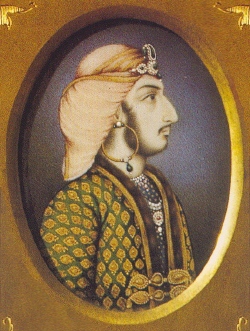The territories of Gajpat Singh were divided between his sons, Bhag Singh and Bhup Singh, the former taking Jind and Safidon with the title of ‘Raja’ and the latter the estate of Badrukhan.
Bhag Singh, was born on September 23, 1760. He succeeded to the chiefship of Jind state in November 1789. In 1786, the districts of Gohana and Kharkhoda were conferred upon him in jagir by Emperor Shah Alam. In 1794, Bhag Singh joined the Patiala army under Rani Sahib Kaur, in the attack on the Maratha generals, Anta Rao and Lachman Rao, at Rajgarh near Ambala. In 1795, Bhag Singh lost Karnal which was occupied by the Marathas and made over to George Thomas.
In 1801, BhagSingh went to Delhi in company with other chiefs to ask General Perron, commanding the northern division of the Maratha army, to crush George Thomas whose existence at Hansi, on the southern border of the Jind state, was a perpetual menace to all the Sikh Jatchiefs in the neighbourhood. This expedition was successful in driving Thomas from Hansi.
Raja Bhag Singh was the first of all the great cis-Satluj chiefs to seek an alliance with the British government. He joined the British camp towards the end of 1803. Bhag Singh joined General Lake in his pursuit of Jaswant Rao Holkar in 1805, accompanying him as an envoy to his nephew, Maharaja Ranjit Singh, to tell him of the approach of General Lake, and warn him against espousing the hopeless cause of Holkar. Bhag Singh exerted considerable influence with Ranjit Singh in favour of the English. The negotiations between Holkar and Ranjit Singh broke off and the Maratha chief was compelled to leave the Punjab. Bhag Singh returned with Lord Lake to Delhi and received the grant of the pargana of Bawanat, immediately to the south-west of Panipat. It was a life -grant in the name of Kanwar Partap Singh.
During the cis-Satluj campaign of Maharaja Ranjit Singh in 1806, Bhag Singh received from, his nephew (the Maharaja), Ludhiana consisting of 24 villages worth Rs. 15,380, a year; 24 villages of Jandiala from the same family, worth Rs. 4370; two villages of Kot and two of Jagraon, worth Rs. 2,000, a year. During the expedition of 1807, Bhag Singh received from the Maharaja three villages of Ghungrana and 27 villages of Morinda in Sirhind, and all together worth Rs. 19,255, a year.
A deputation, which included Raja Bhag Singh, met Mr Seton on March 22, 1808, in Delhi and solicited the English help urgently. He joined General Ochterlony in conducting negotiations with the Sikh chiefs. He put more confidence in the friendship of the English than that of Maharaja Ranjit Singh. Raja Bhag Singh was willing to give up Ludhiana to the English who realised its potentialities as a strategic cantonment on their border. Bhag Singh wanted Karnal in exchange for Ludhiana but the government rejected the proposal for Karnal and allowed the Raja a fair amount of compensation for the loss of Ludhiana. Raja Bhag Singh had three sons, Fateh Singh, Partap Singh and Mehtab Singh.
From the year 1814 onwards, Bhag Singh began to fall seriously out of health. He died on June 16, 1819.
References :-
- Lepel Griffin, op. tit, p. 283; Gian Singh, op. tit, pp. 662-63.
- Lepel Griffin, op. tit, pp. 283-84. Bute Shah wrongly writes that Sukhchain Singh had only two sons, Alam Singh and Gajpat Singh. Bulaki Singh, the third son of Sukhchain Singh was the founder of the Dialpura Branch of the Jind family (Lepel Griffin, op. tit, p. 279).
- Lepel Griffin, op tit, p. 284; Gian Singh, op. tit, pp. 662-63.
- Ibid, p. 284.
- History of the sikhmisls.
- Ibid.
- GianiGian Singh, op. tit, p. 664.


